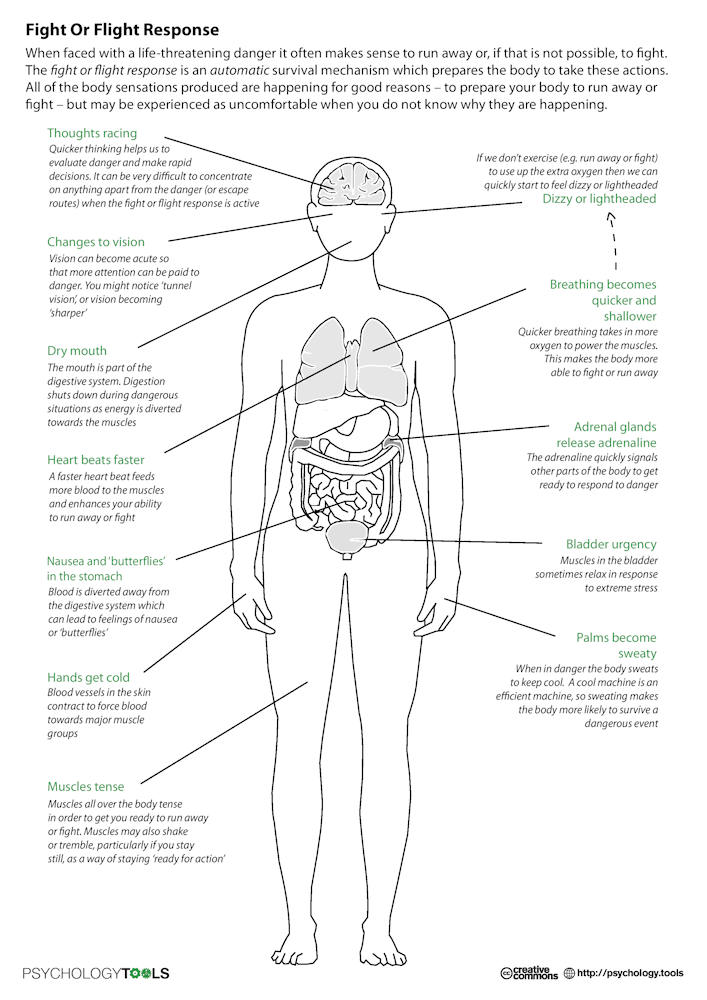Daily Archives: August 30, 2015
Panic & Time Magazine's "How to Increase Mental Toughness: 4 Secrets From Navy SEALs and Olympians" by Eric Barker share
Panic. Our body’s ability to prime itself for a life-saving level of physical response, “fight or flight,” is a gift. It allows us to summon every possible physical resource we have to save ourselves from a physical threat. But, when the threat is imagined or emotional, it feels really yucky to be in physical panic mode. This is especially true because our bodies, in that moment, experience temporary physical changes (i.e. increased heart rate, quick & shallow breathing, increased blood circulation to muscles, decreased blood circulation to the “rational” part of your brain, etc. Click image on the right for more details.) that can feel scary if we don’t understand why it’s happening. However, our body naturally knows how to shift out of this mode when the perception of the threat is gone. Of course, because being in that high alert mode has our body burning off a great deal of our energy in a short amount of time, we’re left feeling exhausted in the aftermath, even if we didn’t actually fight or flee.
(If you can’t see the embedded video at the top of this page, click on the following link for the article and scroll down to the second video on the page that’s titled, “Navy SEALs Mental Training.”) The video displayed at the top of this page and accompanying article explains our body’s normal fight, flight, or freeze response and ways that the Navy SEALs and Olympic athletes train to have as much control as possible over preventing their bodies from triggering this response when they don’t want it.
Emphasis is on understanding the biology behind what is happening in our bodies when we experience fear and then using four basic skills to help our minds not be unnecessarily controlled by fear and panic:
- Positive Self-Talk
- Goal Setting
- Practice Visualization
- Use Simulations (practice)
All of these techniques are key components to CBT (Cognitive and Behavioral Therapy) and are used in therapy sessions with clients every day to treat both excessive anxiety as well as depression. And, if you struggle with “panic attacks”, the fight, flight, or freeze response is technically what is happening in your body (this involves the amygdala, hypothalamus, and adrenaline). It is a normal body function that is being triggered when there is the perception of a threat and prepares us to cope with life threatening situations. However, when it comes to fear, our minds don’t differentiate between physical threats and mental/emotional threats. But, the reality is that that the fight, flight, or freeze response isn’t very helpful when it comes to dealing with mental/emotional threats. So, the better we can use coping skills to prevent ourselves from the panicking, the more success we will have in coping with the challenges we face.
The video also mentions using relaxation breathing as the primary method of quickly recovering from when our fight, flight, or freeze response has been triggered. It talks about how particularly long exhales mimic our body’s normal relaxation mode (which is a new idea for me, I’ll have to find the time to look into the research on that point) and that the increase in oxygen in the bloodstream helps get the more logical, frontal cortex of the brain re-engaged so that you can think through your situation more rationally.
So, the next time you happen to be working on improving your CBT skills, just remember that if it works for the intense challenges that Navy SEALs and Olympic athletes face during actual physical threats, with practice, it will work for you when you’re working on not freaking out about having to do something in every day life like public speaking or taking a trip to the grocery store.


